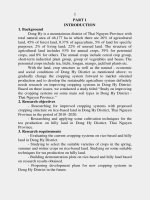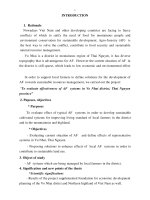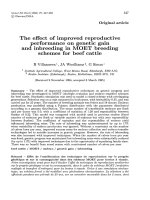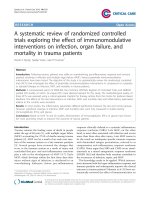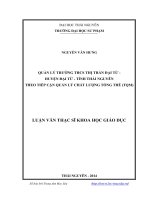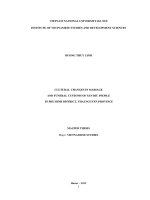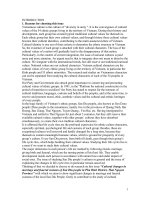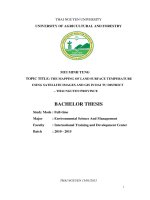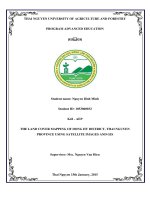The mapping of land surface temperature using satellite images and GIS in dai tu district thai nguyen province
Bạn đang xem bản rút gọn của tài liệu. Xem và tải ngay bản đầy đủ của tài liệu tại đây (1.02 MB, 69 trang )
THAI NGUYEN UNIVERSITY
UNIVERSITY OF AGRICULTURAL AND FORESTRY
MUI MINH TUNG
TOPIC TITLE: THE MAPPING OF LAND SURFACE TEMPERATURE
USING SATELLITE IMAGES AND GIS IN DAI TU DISTRICT
– THAI NGUYEN PROVINCE
BACHELOR THESIS
Study Mode : Full-time
Major
: Environmental Science And Management
Faculty
: International Training and Development Center
Batch
: 2010 - 2015
THAI NGUYEN 15/01/2015
i
Thai Nguyen University of Agriculture and Forestry
Degree program
Bachelor of Environmental Science and Management
Full name
MUI MINH TUNG
Student ID
DTN1053110215
The mapping of land surface temperature using satellite
Thesis title
images and GIS in Dai Tu district - Thai Nguyen province
Supervisor
MSC. NGUYEN VAN HIEU
Abstract:
Land surface temperature is an important factor for a wide variety of
applications such as hydrology, agriculture, biogeochemistry and climate change etc.
as well as an important parameters in researching environmental status, especially
for urban environment. However, calculating LST with the high accuracy has been
one of the biggest preoccupations of scientists due to the influence of the ability of
the surface emission.
Thai Nguyen City, one of the fast-expanding cities and the biggest industrial,
commercial centers in Vietnam, has many aspects of active development under
urbanization. However, that high economic growth brings many impacts of high
pollution levels in to the urban area. Surface temperature and land cover types can
be directly derived from remotely sensed data, which provides a powerful way to
monitor urban environment and human activities.
By using ArcGIS and ENVI software and remote sensing data, the raw
thermal band data of Landsat satellite images are converted to land surface
temperature in degree Celsius. The data is used for detection of surface temperature
i
change during 1996-2014 and estimation of the increased rate of temperature rise to
understand the intensity of global warming in the present and previous period
Dai Tu, Thai Nguyen, GIS, Land surface temperature, Land
Keywords
cover types, ArcGIS software, ENVI software.
Number of pages
63
Date of submission
January 15, 2015
ii
ACKNOWLEDGEMENT
Approved by the Advanced Education Program - Thai Nguyen University of
Agriculture and Forestry, I have successfully conducted the research: “the mapping
land surface temperature using satellite images and GIS tool in Dai Tu district”. First
and foremost, I would like to thank my research supervisors, Msc.Nguyen Van Hieu vice director in “Center for foreign language and applied informatics”, who helped me
a lot during the internship time. Without the assistance and dedicated involvement in
every step throughout the process, this research would have never been accomplished.
I also would like to show gratitude to the employees of spatial research
laboratory, who helped and supported me to accomplish my research. In addition, I
would like to thank my family and my friends by always staying by my side, who
encourage and help me in learning and researching.
Thai Nguyen, 15/01/ 2015
Author
Mui Minh Tung
iii
TABLE OF CONTENTS
LIST OF FIGURES.......................................................................................................1
LIST OF TABLES.........................................................................................................2
LIST OF ABBREVIATIONS .......................................................................................3
PART I. INTRODUCTION..........................................................................................4
1.1. Background and rationale ............................................................................ 4
1.2. Research objectives ..................................................................................... 4
1.3. The requirement........................................................................................... 5
1.4. The significance........................................................................................... 5
PART II. LITERATURE REVIEW ............................................................................6
2.1. Theoretical basis .......................................................................................... 6
2.1.1. The land surface temperature.................................................................... 6
2.1.3.Geographic information systems and remote sensing technology .......... 10
2.2. Practical basis ............................................................................................ 18
2.2.1. The research on land surface temperature in the world.......................... 18
2.2.2. The research on land surface temperature in Viet Nam ......................... 21
PART III. METHODS ................................................................................................24
3.1. Materials .................................................................................................... 24
3.1.1. The objects and scope of research .......................................................... 24
b. The scope ...................................................................................................... 24
3.1.2. The content ............................................................................................. 24
3.2. Methods ..................................................................................................... 24
3.2.1. Collecting and selecting data. ................................................................. 24
3.2.2. Inherited method ..................................................................................... 25
3.2.3. Determining land surface temperature. .................................................. 25
3.2.4. Land cover classification ........................................................................ 28
iv
3.2.5. Map editor............................................................................................... 32
PART IV. RESULTS...................................................................................................33
4.1. The natural conditions and socioeconomic in research area ..................... 33
4.1.1. Natural conditions................................................................................... 33
4.1.2. Socioeconomic conditions ...................................................................... 41
4.1.3. Summary of the current land used and land management activities in Dai Tu
.......................................................................................................................... 44
4.1.4. General assessment of the natural conditions, socioeconomic conditions and
environment in research area ............................................................................ 46
4.2. Determining land surface temperature....................................................... 46
4.2.1. Data Investigation and collection ........................................................... 46
4.2.2. Conversion of the Digital Number (DN) to Spectral Radiance (Lλ)...... 47
4.2.3. Conversion of the Spectral Radiance to Temperature ............................ 48
4.3. Land cover types classification.................................................................. 52
4.4. Map editor.................................................................................................. 56
PART V. DISCUSSION AND CONCLUSION ........................................................59
5.1. Discussion.................................................................................................. 59
5.2. Conclusion ................................................................................................. 59
REFERENCES ............................................................................................................61
v
LIST OF FIGURES
Figure 3.1. Determining land surface temperature process...........................................25
Figure 3.2. Land cover classification process ...............................................................29
Figure 3.3. Map editor process ......................................................................................32
Figure 4.1. The administration map of Dai Tu district 2013.........................................33
Figure 4.2. The average temperature in Dai Tu observation station year 2013 ............40
Figure 4.3. Landsat thermal band ..................................................................................47
Figure 4.4. Band marth tool...........................................................................................48
Figure 4.5. Spectral Radiance image.............................................................................48
Figure 4.6. Emissivity Normalization tool. ...................................................................49
Figure 4.7. Land surface temperature in 1996...............................................................49
Figure 4.8. Land surface temperature in 2014...............................................................50
Figure 4.9. Composited bands .......................................................................................52
Figure 4.10. Clip function tool ......................................................................................53
Figure 4.11. NDVI map.................................................................................................53
Figure 4.12. Land cover type map in 1996……………………………………………55
Figure 4.13. Land cover type map in 2014....................................................................55
Figure 4.14. Data frame tool..........................................................................................56
Figure 4.15. the locator map..........................................................................................57
Figure 4.16. Other map elements ..................................................................................57
Figure 4.17. Land surface temperature map 1996.........................................................58
Figure 4.18. Land surface temperature map 2014.........................................................58
1
LIST OF TABLES
Table 3.1. K1 and K2 Values in Landsat 8 images .......................................................27
Table 3.2. Rescaling Factor ...........................................................................................27
Table 3.3. The K1, K2 value in Landsat 5 images ........................................................28
Table 3.4. Rescaling Factor of Landsat 5 images..........................................................28
Table 3.5. Band Combinations for Landsat 8................................................................31
Table 4.1. Dai Tu district area divided by the height and slope....................................34
Table 4.2. The average rainfall in some observation station of Dai Tu district ............38
Table 4.3. Monthly mean humidity of Dai Tu district in recent years ..........................39
Table 4.4. Land use structure of Dai Tu district in 2014...............................................45
Table 4.5. Land cover classification..............................................................................54
Table 4.6. Land cover statistical....................................................................................55
2
LIST OF ABBREVIATIONS
CAD
Computer-Aided Design
CARIS
Computer Aided Resource Information System
DN
Digital number
DOS
Disk Operating System
ERDAS
Earth Resource Data Analysis System
ERSI
Environmental Systems Research Institute
GIS
Geographic InformationSystems
GPS
Global Positioning System
LIDAR
Light Detection And Ranging
LST
Land surface temperature
MIDAS
Mapping Display and Analysis System
RADAR Radio Detection And Ranging
RS
Remote sensing
UCL
Urban Canopy Layer
UBL
Urban Boundary Layer
UHI
Urban Heat Island
3
PART I. INTRODUCTION
1.1. Background and rationale
Land surface temperature is an important factor for a wide variety of
applications such as hydrology, agriculture, biogeochemistry and climate change etc.
as well as an important parameters in researching environmental status, especially for
urban environment. However, calculating LST with the high accuracy has been one of
the biggest preoccupations of scientists due to the influence of the ability of the surface
emission. Observing land surface temperature in a province becomes more difficult
because we cannot build a system of weather stations with the high density and
continuous operation. Remote sensing data with the characteristics of multiphase, short
time to process and covering the wide region enable the users to observe the location
particularly and continuously, as well as the temperature change of a certain area.
Thai Nguyen is one of the provinces developing rapidly with high
industrialization and urbanization rate. It causes the changes in its land surface
temperature especially in Dai Tu district areas. For the reason mentioned above, I
choose the topic “The land surface temperature mapping of Dai Tu district, Thai
Nguyen province using satellite image and GIS”; to better serve environmental
management and natural resource supervision purposes, together with evaluating the
application of remote sensing in studying the temperature.
1.2. Research objectives
- Researching the land surface temperature in Dai Tu district
- Mapping the land surface temperature of Dai Tu district.
- Assessing the impact of land cover to the land surface temperature in Dai Tu.
4
1.3. The requirement
- To acquire adequate data of natural condition, socioeconomic and spatial data.
- To classify and process the data.
- To evaluate the impact of land surface temperature changes on distribution of
the land cover types.
- To be proficient in GIS software to mapping data and analyzing data.
1.4. The significance
- For learning and researching purpose: to apply the researching methods, ways
to evaluating the changes in land surface temperature and analyzing the impact of land
surface temperature to the land cover types.
- The practical significance: Applying the knowledge on reality combine with
collecting and analyzing data, assessing the impact of land surface temperatures
changed, providing information to local community in the research area about land
surface temperature changes and its effects and then suggest several reasonable
strategies and measures from predictions in the thesis.
5
PART II. LITERATURE REVIEW
2.1. Theoretical basis
2.1.1. The land surface temperature
2.1.1.1. The concept and the role of surface temperature
Temperature is an essential atmospheric variable which is a transformation of
the kinetic energy of the particles inside any object or matter into heat energy. The
land surface temperature (LST) which is retrieved from satellite remote sensing is the
skin temperature of the surface of the Earth. This is captured in the thermal infrared
region of the electromagnetic spectrum (Fontana et al., 2005). “The land surface
temperature (LST) is an important factor controlling most physical, chemical and
biological processes in the Earth” (Fontana et al., 2005). Various environmental
studies and management activities of the Earth surface resources require the
knowledge of LST (Li and Becker, 1993). Therefore, the studies using LST is of great
importance withrespect to the environmental and climate change scenarios.
Land Surface Temperature (LST) is an important climate variable, related to
surface energy balance and the integrated thermal state of the atmosphere within the
planetary boundary layer. Traditionally, LST was referred to standard surface-air
temperature measured by a sheltered thermometer 1.5-3.5 m above a flat grassy, wellventilated surface. With satellite technology, another type of LST, satellite-based
surface temperature called skin temperature, is becoming available globally. Satellite
LST products provide an estimate of the kinetic temperature of the earth’s surface
skin, i.e., the aggregate surface medium viewed by the sensor to a depth of about 12
μm. Skin temperature is inferred from the thermal emission of the earth surface and is
6
generally some average effective radioactive temperature of various canopy and soil
surfaces.
LST is a key parameter in land surface processes, not only acting as an
indicator of climate change, but also due to its control of the upward terrestrial
radiation, and consequently, the control of the surface sensible and latent heat flux
exchange with the atmosphere. For example, energy exchanges at the land-surface
boundary are largely controlled by the difference between the skin temperature and the
surface air temperature, the air and the surface reacting with different time and space
scales to external forcing while still being complexly interconnected. Moreover, the
surface temperature responds more rapidly to changes of the local balance of energy
than the air temperature. On the other hand, surface heat fluxes can induce local
convection in the boundary layer, producing changes in air temperature, surface winds,
cloudiness, and (potentially) precipitation.
2.1.1.2. The situation of land surface temperature in research area
Thai Nguyen is a major commercial center of the Northern areas of Vietnam
and one of the cities developing rapidly with high industrialization and urbanization
rates. The temperature here is remarkably increasing, especially in Dai Tu district area
in northwest of Thai Nguyen city.
2.1.1.3. The causes of increased land surface temperature.
The land surface temperature significantly increased due to the rapidly
industrialization and urbanization in Thai Nguyen city. Residential area expansion is
one of the factors that cause more heat reflection and raise the surface temperature in
urban area. The roof and asphalt make the reflectivity occurred and cause surface
7
temperature and overall ambient air temperature in urban area to rise. In addition, the
higher deforestation rate contributes to the land cover changes, leading to land surface
temperature change.
2.1.1.4. The impacts
There are many impacts due to the surface temperature rise, such as on human
health, natural vegetation, fauna and flora, and surrounding environment, and most of
all it is the key factor causing global warming. In addition, the higher temperature in
urban zones is the main reason for “heat island effect”, which is a large environmental
problem in many big cities where the temperature increases continuously together with
the urbanization and industrialization.
2.1.2. The land cover types
2.1.2.1. Land cover types definition
Land cover data documents how much of a region is cover by forests, wetlands,
impervious surfaces, agriculture, and other land and water types. Water types include
wetlands or open water. The different types of land cover can be managed or use quite
differently. Land cover can be determined by analyzing satellite and aerial imagery.
Land cover maps provide information to help managers best understand the current
landscape. To see change over time, land cover maps for several different years are
needed. With this information, managers can evaluate past management decisions as
well as gain insight into the possible effects of their current decisions before they are
implemented.
Coastal managers use land cover data and maps to better understanding the
impacts of natural phenomena and human use of the landscape. Maps can help
8
managers assess urban growth, model water quality issues, predict and assess impacts
from floods and storm surges, track wetland losses and potential impacts from sea
level rise, prioritize areas for conservation efforts, and compare land cover changes
with effects in the environment or to connections in socioeconomic changes such as
increasing population.
2.1.2.2. The land used in research area
The land area of Dai Tu district is 57.890 ha, in which 26.87% of agricultural
land, forestland accounted for 45.13%, the rest are non-agricultural land accounting for
28% with mostly hills and rivers. The forest areas of Dai Tu are 24.468 ha, in which
over 9.000 ha of plantation forest and 15.000 ha of natural forest. Now, many planted
areas are old enough to exploit, otherwise, there are many large areas can be used to
plant tree. So, it is necessary to improve the coverage and develop the high-value
forest.
2.1.2.3. The causes of land cover changes in research area
The main causes of land cover change is deforestation and over exploitation.
Otherwise, in recent years, due to the rapid development of industry in urban area, there are
many works and factories built, resulting inland cover changes.
2.1.2.4. The impact
The land cover change had widely impact on climate and atmosphere. The full
impact of land cover change on climate and ecosystems is an open question, with a
multitude of perspectives to account for, and is far beyond the scope of this work.
However, in many respects land cover change has had the single largest impact on
ecosystem services, and society in general, of any human endeavor. Land cover
9
change primarily influences the climate and atmosphere through either bio geophysical
or biogeochemical processes.
In general, biogeochemical impacts of land cover change on climate refer to
perturbations in climate from changes in the fluxes of chemical compounds, primarily carbon
dioxide, which impact atmospheric chemistry and radioactive energy balance.
Bio geophysical impacts of land cover change represent perturbations to a more
direct coupling between the land and the atmosphere. At the earth’s surface, fluxes of
energy, moisture, and momentum take place between the atmospheric boundary layer
and soil/vegetation. As the vegetative structure of a region is perturbed due to land use,
these fluxes respond and change.
2.1.3.Geographic information systems and remote sensing technology
2.1.3.1. Geographic information system (GIS)
a. Definition
A geographic information system (GIS) is a computer system designed to capture,
store, manipulate, analyze, manage, and present all types of spatial or geographical data. The
acronym GIS is sometimes used for geographical information science or geospatial
information studies to refer to the academic discipline or career of working with geographic
information systems and is a large domain within the broader academic discipline of Geoinformatics. What goes beyond a GIS is a spatial data infrastructure, a concept that has no
such restrictive boundaries.
In a general sense, the term describes any information system that integrates
stores, edits, analyzes, shares, and displays geographic information. GIS applications
are tools that allow users to create interactive queries (user-created searches), analyze
10
spatial information, edit data in maps, and present the results of all these operations.
Geographic information science is the science underlying geographic concepts,
applications, and systems.
b. Basic elements of GIS
- Hardware: Hardware is the computer system on which a GIS operates. Today, GIS
software runs on a wide range of hardware types, from centralized computer servers to
desktop computers used in stand-alone or networked configurations.
- Software: GIS software provides the functions and tools needed to store,
analyze, and display geographic information. A review of the key GIS software
subsystems is provided above.
- Data: Perhaps the most important component of a GIS is the data. Geographic
data and related tabular data can be collected in-house, compiled to custom
specifications and requirements, or occasionally purchased from a commercial data
provider. A GIS can integrate spatial data with other existing data resources, often
stored in a corporate DBMS. The integration of spatial data (often proprietary to the
GIS software), and tabular data stored in a DBMS is a key functionality afforded by
GIS.
- People: GIS technology is of limited value without the people who manage the
system and develop plans for applying it to real world problems. GIS users range from
technical specialists who design and maintain the system to those who use it to help them
perform their everyday work. The identification of GIS specialists versus end users is often
critical to the proper implementation of GIS technology.
11
- Methods: A successful GIS operates according to a well-designed
implementation plan and business rules, which are the models and operating practices
unique to each organization.
As in all organizations dealing with sophisticated technology, new tools can only be
used effectively if they are properly integrated into the entire business strategy and
operation. To do this properly requires not only the necessary investments in hardware and
software, but also in the retraining and/or hiring of personnel to utilize the new technology
in the proper organizational context. Failure to implement your GIS without regard for a
proper organizational commitment will result in an unsuccessful system. Many of the issues
concerned with organizational commitment are described in Implementation Issues and
Strategies.
c. GIS application.
There are five basic questions which a complete GIS must answer:
What exists at a particular location?Given a geographic reference (eg. lattitude and
longitude) for a location, the GIS must describe the features of that location.
Where can specific features be found? This is the converse of the first question.
For example, where are the districts with rainfall greater than 500 mmand less than
less than 750 mm?
Trends or what has changed over time?This involves answering both questions
above. For example, at what locations are the crop yields showing declining trends?
What spatial patterns exist? If occurrence of a pest is associated with a
hypothesized set of conditions of temperature, precipitation, humidity, where do those
conditions exist?
12
Modelling or what if …?This is a higher level application of GIS and answers
questions like what would be the nitrate distribution in groundwater over the area if
fertilizer use is doubled?
d. GIS funtion:
Data Pre-processing and Manipulation
- Data validation and editing, eg. checking and correction.
- Structure conversion, eg. conversion from vector to raster.
- Geometric conversion, eg. map registration, scale changes, projection
changes, map transformations, rotation.
- Generalisation and classification, eg. reclassifying data, aggregation or
disaggregation, co-ordinate thinning.
- Integration, eg overlaying, combining map layers or edge matching.
- Map enhancement, eg. image enhancement, add title, scale, key, map
symbolism, draping overlays.
- Interpolation, eg. kriging, spline functions, Thiessen polygons, plus centroid
determination and extrapolation.
- Buffer generation, eg. calculating and defining corridors.
- Data searching and retrieval, eg. on points, lines or areas, on user defined themes
or by using Boolean logic. Also browsing, querying and windowing.
Data Analysis
- Spatial analysis, eg. connectivity, proximity, contiguity, intervisibility, digital
terrain modelling.
13
- Statistical analysis, eg. histograms, correlation, measures of dispersion,
frequency analysis.
- Measurement, eg. line length, area and volume calculations, distance and directions.
Data Display
- Graphical display, eg. maps and graphs with symbols, labels or annotations.
- Textual display, eg. reports, tables.
Database Management
- Support and monitoring of multi-user access to the database.
- Coping with systems failure.
- Communication linkages with other systems.
- Editing and up-dating of databases.
- Organising the database for efficient storage and retrieval.
- Maintenance of database security and integrity.
- Provision of a “data independent” view of the database.
e. ArcGIS software introduction.
ArcGIS is a software program, used to create, display and analyze geospatial
data, developed by Environmental Systems Research Institute (ESRI) of Redlands,
California. ArcGIS consists of three components: ArcCatalog, ArcMap and
ArcToolbox. ArcCatalog is used for browsing for maps and spatial data, exploring
spatial data, viewing and creating metadata, and managing spatial data. ArcMap is
used for visualizing spatial data, performing spatial analysis, and creating maps to
show the results of your work. ArcToolbox is an interface for accessing the data
conversion and analysis function that come with ArcGIS. ArcGIS comes in three
14
variants: ArcView, ArcEditor, or ArcInfo, which are the low end, middle and fully
configured versions of the software. Any of these versions can be used for this
exercise.
ArcGIS allowing:
- Creating and editing the integrated data (spatial data and attribute data)
- Spatial querying from many sources by different ways
- Display, query and analyze spatial data
- Create thematic maps and high quality printouts.
ArcGIS data structure:
The ArcGIS data are dividing to three parts:
- Vector: a set of specific classes has the same reference system.
- Raster: a set of simply data or a compressed data set from wavelength bands
of spectrum or a list of values.
- TIN: contains a set of accurately continuous triangle of a region with the Z
value for each point.
2.1.3.2. Remote sensing (RS)
a. Definition
Remote sensing is the acquisition of information about an object or
phenomenon without making physical contact with the object and thus in contrast to in
situ observation. In modern usage, the term generally refers to the use of aerial sensor
technologies to detect and classify objects on Earth (both on the surface, and in
the atmosphere and oceans) by means of propagated signals (e.g. electromagnetic
radiation). It may be split into active remote sensing (when a signal is first emitted
15
from aircraft or satellites) or passive (e.g. sunlight) when information is merely
recorded.
b. Basic Elements of GIS Remote sensing
Energy Source or illumination - the first requirement for remote sensing is to
have an energy source, which illuminates or provides electromagnetic energy to the
target of interest.
Radiation and the atmosphere - as the energy travels from its source to the
target, it will come in contact with and interact with the atmosphere it passes through.
This interaction may take place a second time as the energy travels from the target to
the sensor.
Interaction with the target - once the energy makes its way to the target
through the atmosphere, it interacts with the target depending on the properties of both
the target and the radiation.
Recording of Energy by the Sensor - after the energy has been scattered by, or
emitted from the target, we require a sensor (remote - not in contact with the target) to
collect and record the electromagnetic radiation.
Transmission, Reception, and Processing - the energy recorded by the sensor has to
be transmitted, often in electronic form, to a receiving and processing station where the data
are processed into an image (hardcopy and/or digital).
Interpretation and Analysis - the processed image is interpreted, visually and/or
digitally or electronically, to extract information about the target which was
illuminated.
16
Application - the final element of the remote sensing process is achieved when
we apply the information we have been able to extract from the imagery about the
target in order to better understand it, reveal some new information, or assist in solving
a particular problem.
c. Some Land Observation Satellites/Sensors
The Landsat:
- System Pour l Observation de la Terre (SPOT);
- Indian Remote Sensing (IRS);
- Light Detection And Ranging (Lidar);
- Marine Observation Satellite (MOS);
- Sea-viewing Wide-Field-of View Sensor (SeaWiFS);
- Forward Looking Infrared (FLIR);
- Radio Detection And Ranging (RADAR)
The Land sat program is the longest running enterprise for acquisition of satellite
imagery of Earth. On July 231972, the Earth Resources Technology Satellite was
launched. This was eventually renamed to Landsat .The most recent, Landsat 8, was
launched on February 11, 2013. The instruments on the Landsat satellites have acquired
millions of images. The images, archived in the United States a data Landsat receiving
stations around the world, are a unique resource for global change research and
applications in agriculture, cartography, geology, forestry, regional planning, surveillance
and education, and can be viewed through the USGS 'Earth Explorer' website. Landsat 7
data has eight spectral bands with spatial resolutions ranging from 15 to 60 meters; the
temporal resolution is 16 days.
17
d. Applications of RS data
Agriculture:Crop Type Mapping; Crop Monitoring and Damage Assessment
Forestry: Clear Cut Mapping and Deforestation; Species Identification and
Typing; Burn Mapping
Geology: Structural Mapping and Terrain Analysis; Geologic Unit Mapping
Hydrology: Flood delineation and Mapping; Soil Moisture
SeaIce: Ice type and Concentration; Ice Motion
Land Cover - Biomass Mapping: Land Cover and Land Use; Land Use Change
(Rural / Urban)
Mapping: Planimetry; Digital Elevation Model; Topographic and Baseline
Thematic Mapping
Oceans and Coastal Monitoring: Ocean Features: Ocean Colour and
Phytoplankton Concentration; Oil Spill Detection
2.2. Practical basis
2.2.1. The research on land surface temperature in the world
GIS is designed as a common system for managing spatial data, there are many
applications of GIS in the urban development and natural environments management such
as: urban planning, workforce management, agriculture, operating system utility,
roadmap, inhabitants, mapping, monitoring the waters, fire and disease… Application of
GIS to the study of urban surface temperature is one of the latest applications of GIS.
Urban climate studies have long been concerned about the magnitude of the difference in
observed ambient air temperature between cities and their surrounding rural regions,
which collectively describe the urban heat island (UHI) effect (Landsberg, 1981).
18
Pertinent to the methods of temperature measurement, two types of UHI can be
distinguished: the canopy layer (UCL) heat island, and the boundary layer (UBL) heat
island .
Researching Temperature Modeling of Indus Basin Using Landsat Databy H.U.
Abbasi. The research using
remotely
sensed
information
to
detect
thermal
characteristics and measurements of temperature of Indus basin surfaces and
impact
on
regional
climate.
The
satellite
borne instruments can provide
quantitative and quality physical data at high spatial, temporal resolutions and
repetitive coverage,
capability of measurements of earth surface conditions. The
analysis of surface temperature using thermal infrared band 6, was also carried out
to find out the significant change in temperature, the results have show temperature
from May 1992, May 2003 to May, 2009 ( Abbasi at al., 2012).
Jose´ A. Sobrino performed a study Land surface temperature retrieval from
LANDSAT TM 5, In this paper, three methods to retrieve the land surface temperature
(LST) from thermal infrared data supplied by band 6 of the Thematic Mapper (TM) sensor
onboard the Landsat 5 satellite are compared. The first of them lies on the estimation of the
land surface temperature from the radiative transfer equation using in situ radiosounding
data. The land surface emissivity (LSE) values needed in order to apply these methods have
been estimated from a methodology that uses the visible and near infrared bands. Finally,
we present a comparison between the LST measured in situ and the retrieved by the
algorithms over an agricultural region of Spain (La Plana de Requena-Utiel) ( Sobrino at al.,
2004).
19
